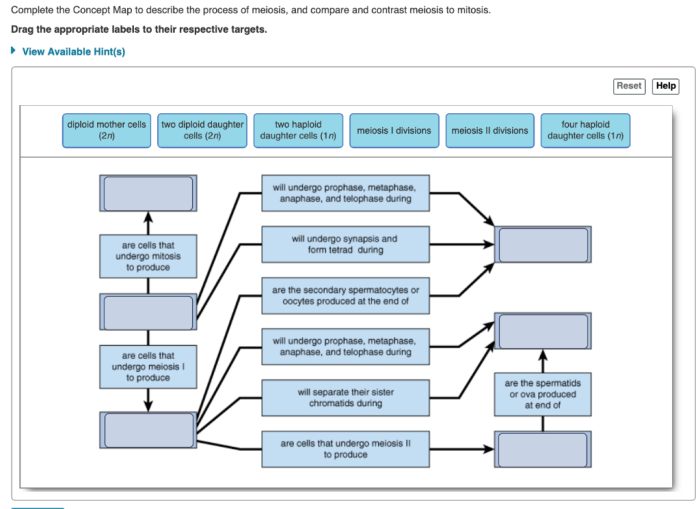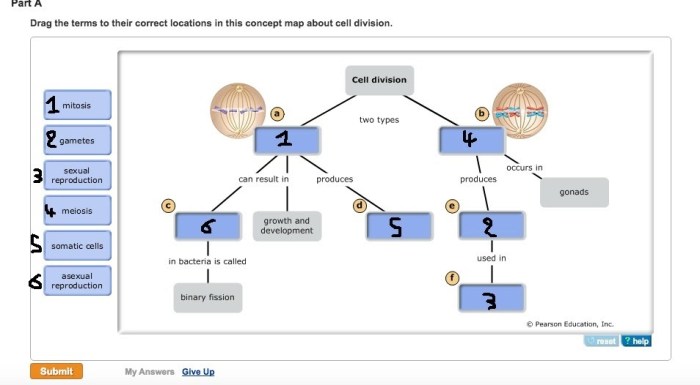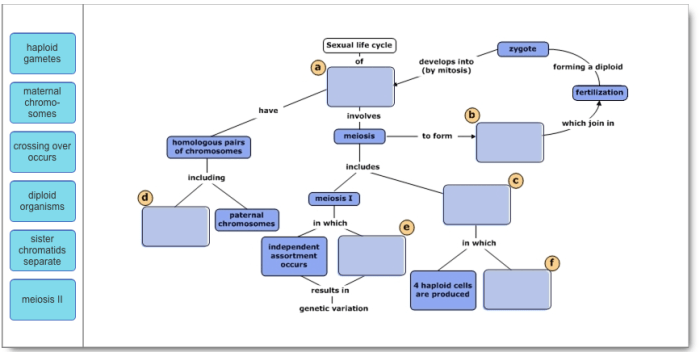Unveiling the complexities of meiosis, Part A – Meiosis Concept Map serves as an indispensable guide, presenting a comprehensive exploration of this fundamental biological process. Join us as we delve into the intricacies of meiosis, unraveling its significance in sexual reproduction and genetic diversity.
Through the lens of a concept map, we will visualize the key stages and phases of meiosis, gaining a deeper understanding of synapsis, crossing over, and the independent assortment of chromosomes. Moreover, we will examine the practical applications of meiosis in genetics, agriculture, and medicine, highlighting its profound impact on scientific advancements.
Overview of Meiosis

Meiosis is a specialized type of cell division that occurs in the reproductive organs of sexually reproducing organisms. Its primary purpose is to produce gametes (sex cells), such as sperm and eggs, which contain half the number of chromosomes as the parent cells.
Meiosis is a complex process that involves two rounds of division, resulting in four haploid daughter cells. The key stages and phases involved in meiosis are as follows:
Stages of Meiosis
- Interphase:The cell grows and replicates its chromosomes before entering meiosis.
- Meiosis I:Consists of prophase I, metaphase I, anaphase I, and telophase I. During prophase I, homologous chromosomes pair up and exchange genetic material through a process called crossing-over. In metaphase I, the paired chromosomes line up at the equator of the cell.
Part A of the meiosis concept map covers the fundamental principles of meiosis, the process by which sex cells are produced. To delve deeper into this topic, you may also find the hunter ed answers unit 2 helpful, as it provides insights into related concepts.
Nevertheless, the meiosis concept map remains an essential resource for understanding the intricacies of meiosis.
In anaphase I, the homologous chromosomes separate and move to opposite poles of the cell. In telophase I, two haploid daughter cells are formed.
- Meiosis II:Consists of prophase II, metaphase II, anaphase II, and telophase II. During prophase II, the chromosomes condense again. In metaphase II, the chromosomes line up at the equator of the cell. In anaphase II, the sister chromatids separate and move to opposite poles of the cell.
In telophase II, four haploid daughter cells are formed.
Meiosis is a crucial process in sexual reproduction as it ensures the maintenance of the species’ chromosome number and genetic diversity. It allows for the recombination of genetic material from both parents, resulting in offspring with unique combinations of traits.
Synapsis and Crossing Over: Part A – Meiosis Concept Map
Synapsis is a crucial process in meiosis that brings homologous chromosomes together, facilitating genetic recombination and the exchange of genetic material. This process plays a significant role in creating genetic diversity, which is essential for the survival and adaptation of species.
Crossing Over
During synapsis, homologous chromosomes pair up and align precisely. At specific points along their lengths, they exchange genetic material through a process called crossing over. This exchange results in the formation of new chromosomes that contain a combination of genetic information from both parents.
Crossing over is a highly regulated process that occurs at specific regions called chiasmata. The frequency and location of crossing over events are influenced by genetic factors and environmental conditions.
Impact of Crossing Over
Crossing over has a profound impact on the inheritance of traits. By creating new combinations of alleles, it increases genetic diversity within a population. This diversity provides the raw material for natural selection to act upon, allowing populations to adapt to changing environmental conditions.
- Example:In humans, the inheritance of eye color is influenced by multiple genes. Crossing over during meiosis can result in new combinations of alleles, leading to a wider range of eye colors in the population.
Independent Assortment of Chromosomes

The principle of independent assortment states that the alleles of different genes assort independently of one another during gamete formation. This means that the inheritance of one gene does not influence the inheritance of another gene. This principle is a fundamental concept in genetics and contributes significantly to genetic variation.
During meiosis I, the homologous chromosomes align randomly at the metaphase plate. This random alignment leads to different combinations of maternal and paternal chromosomes in each gamete. As a result, each gamete carries a unique combination of alleles for different genes.
Examples of Independent Assortment
Consider a pea plant with two genes: one for flower color (red or white) and one for plant height (tall or short). If the plant is heterozygous for both genes (RrTt), it will produce four types of gametes in equal proportions: RT, Rt, rT, and rt.
This means that each gamete has a 25% chance of carrying any one of these four combinations of alleles.
The principle of independent assortment has important implications for the inheritance of multiple traits. For example, if two genes are located on different chromosomes, they will assort independently of each other. This means that the probability of inheriting a specific combination of alleles for these two genes is simply the product of the probabilities of inheriting each allele individually.
Haploid Gamete Formation

The process of meiosis culminates in the formation of haploid gametes, which are the sex cells that participate in sexual reproduction. The genetic makeup of these gametes is crucial for ensuring the successful continuation of species.
Cytokinesis in Haploid Gamete Formation
Cytokinesis is the process by which the cytoplasm of a cell divides, resulting in the formation of two or more daughter cells. In the context of meiosis, cytokinesis occurs twice, resulting in the formation of four haploid gametes from a single diploid cell.
Significance of Haploidy in Sexual Reproduction
Haploidy, the condition of having half the number of chromosomes as a diploid cell, is essential for sexual reproduction. During fertilization, the haploid gametes from two parents combine to form a diploid zygote, which develops into a new individual. Haploidy ensures that each parent contributes an equal number of chromosomes to the offspring, maintaining the species’ chromosome number from generation to generation.
Genetic Makeup of Haploid Gametes vs. Diploid Cells, Part a – meiosis concept map
The genetic makeup of haploid gametes differs significantly from that of diploid cells. Haploid gametes contain only one set of chromosomes, while diploid cells contain two sets. This difference is due to the reduction division that occurs during meiosis, which separates homologous chromosomes and distributes them into different gametes.
Applications of Meiosis

Meiosis, the process of cell division that produces gametes (sex cells), has far-reaching applications in various fields, including genetics, agriculture, and medicine.
In genetics, meiosis plays a crucial role in the study of inheritance patterns and genetic disorders. By analyzing the meiotic products of individuals with genetic conditions, researchers can identify the specific chromosomal abnormalities or mutations responsible for the disorders. This knowledge aids in genetic counseling, prenatal diagnosis, and the development of targeted therapies.
Genetically Modified Organisms
Meiosis is essential for the creation of genetically modified organisms (GMOs). By manipulating the meiotic process, scientists can introduce specific genetic traits into organisms, such as resistance to pests or herbicides in crops. GMOs have the potential to enhance food production, reduce the need for chemical treatments, and improve nutritional content.
Medicine
In medicine, meiosis is used to study the development of reproductive disorders and infertility. By examining the meiotic products of individuals with reproductive issues, doctors can identify chromosomal abnormalities or genetic mutations that may be causing the problems. This information guides treatment options and helps couples make informed decisions about their reproductive health.
Q&A
What is the purpose of meiosis?
Meiosis is essential for sexual reproduction, ensuring the creation of genetically diverse gametes (eggs and sperm) that combine to form new individuals.
How does crossing over contribute to genetic diversity?
Crossing over shuffles genetic material between homologous chromosomes, resulting in the exchange of genetic information and increased genetic variation.
What is the significance of haploidy in gametes?
Haploidy reduces the chromosome number by half, ensuring that fertilization restores the diploid chromosome number in the offspring.